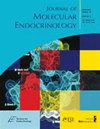Retinoic acid receptors at 35: molecular convergence of vitamin A and steroid hormone action.
IF 3.6
4区 医学
Q2 ENDOCRINOLOGY & METABOLISM
Journal of molecular endocrinology
Pub Date : 2022-10-11
Print Date: 2022-11-01
DOI:10.1530/JME-22-0155
引用次数: 0
Abstract
The fields of vitamins and steroid hormones emerged in parallel in the early parts of the twentieth century. Scientists in both fields were initially interested in the purification of natural compounds present respectively in food stuff and extracts from organs and biological fluids that had profound effects on reproduction, development, and general maintenance of a healthy organism. Coincidently, the chemical structure of vitamin A and the steroid hormones oestradiol and progesterone were resolved around the same time in the mid 1930s. From these early common grounds, the fields of vitamin A and steroid hormones then diverged into their respective branches of biological sciences, mainly nutrition/vision and endocrinology for the next several decades. Yet, 50 years later, it is the surprising discovery that retinoic acid (RA), an active metabolite of vitamin A, exerts its biological effects via a member of the superfamily of steroid receptors that led to the improbable reunification of vitamin A and steroid hormones action. We celebrate the scientific milestone of the discovery of the retinoic acid receptor (RAR) with a special issue of the Journal of Molecular Endocrinology. This issue comprises chronicles reminiscing how that discovery was achieved independently by two young Canadian scientists working in the laboratories of Ronald Evans and Pierre Chambon separated by a continent and an ocean, and reviews by international experts describing distinct aspects of RAR-dependent biology and mode of action.视黄酸受体在35:分子收敛的维生素A和类固醇激素的作用。
本文章由计算机程序翻译,如有差异,请以英文原文为准。
求助全文
约1分钟内获得全文
求助全文
来源期刊

Journal of molecular endocrinology
医学-内分泌学与代谢
CiteScore
6.90
自引率
0.00%
发文量
96
审稿时长
1 months
期刊介绍:
The Journal of Molecular Endocrinology is an official journal of the Society for Endocrinology and is endorsed by the European Society of Endocrinology and the Endocrine Society of Australia.
Journal of Molecular Endocrinology is a leading global journal that publishes original research articles and reviews. The journal focuses on molecular and cellular mechanisms in endocrinology, including: gene regulation, cell biology, signalling, mutations, transgenics, hormone-dependant cancers, nuclear receptors, and omics. Basic and pathophysiological studies at the molecule and cell level are considered, as well as human sample studies where this is the experimental model of choice. Technique studies including CRISPR or gene editing are also encouraged.
 求助内容:
求助内容: 应助结果提醒方式:
应助结果提醒方式:


